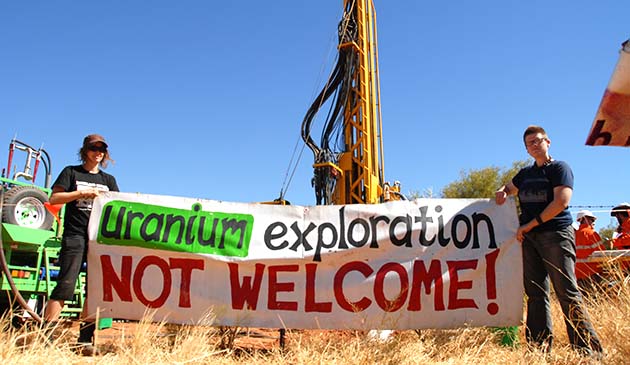Opponents of the NT Intervention have long maintained that its initial, stated aim—to protect Aboriginal children from sexual abuse—was an emotive smokescreen. So what is the real agenda, asks Paddy Gibson
The Australian Crime Commission, with extraordinary interrogation powers, reported in July that no “pedophile rings” operated in communities. The government’s own reports clearly show deteriorating conditions for children.
So what is behind the Intervention?
Many on the left propose an easy answer—the Intervention is a land grab for mining companies.
Prominent journalist John Pilger has promoted this view, “The Territory contains extraordinary mineral wealth on Aboriginal land… (the Intervention) has all to do with open slather uranium mining and converting the NT into a global nuclear dump”.
Attempting to disarm their critics, Labor is actually planning to ban mining on land acquired through the Intervention. But they can do this because the Intervention has never been about mining.
Land takeover
 The Intervention took out compulsory 5-year leases over Aboriginal land, creating “Prescribed Areas” where Intervention powers apply.
The Intervention took out compulsory 5-year leases over Aboriginal land, creating “Prescribed Areas” where Intervention powers apply.
But leases are restricted to townships and do not extend out over the vast tracts of Aboriginal land that contain prized mineral deposits. The suspension of the “permit system” (which Labor has introduced legislation to reinstate), also only applied to the townships.
Mining companies gained no greater rights through the Intervention. They still need permission from Aboriginal landowners to explore or mine on Aboriginal land and must undertake these negotiations through appropriate Land Councils. The integrity of these processes had already come under attack through ammendments to the Land Rights Act passed in 2006.
Some have pointed to the sharp spike in mineral exploration taking place in the NT as evidence that the Intervention is about mining.
In 2007/08, money spent on uranium exploration in the NT jumped from $30.1 to $34.9 million, or 16 per cent. But in Queensland there was a jump from $9 to $24.2 million and Australia wide the rate of increase was 48 per cent.
Increases were a result of the mining boom, and industry hopes of a “nuclear renaissance”, not the Intervention.
Pilger also claimed, “the government appropriated Aboriginal land near Tennant Creek, where it plans to store nuclear waste”.
But the land at Muckaty station earmarked for the dump continues to be owned by Aboriginal people through the Muckaty Land Trust. The government has secured an agreement with a tiny minority of people on the land trust, exploiting the poverty of the community by offering a $12 million package.
This analysis doesn’t deny the ruthlessness of the mining and nuclear industries. From the Angela Pamela uranium deposit near Alice Springs to the growing fight against plans for the Muckaty dump—people are fighting back and need solidarity.
Slashing services will increase the pressure on already desperate communities to strike deals with these industries, or look to others such as tourism. But Intervention laws serve a more serious and insidious purpose.
Assimilation
The appalling conditions facing Aboriginal people in Australia have long been a source of international embarrassment and domestic resistance.
John Howard vigorously blamed Aboriginal people and culture for these problems, arguing that “self-determination” had failed and that the only future lies through the market and assimilation into urban society.
This helped to entrench a more general “blame the victim” mentality. It also went hand in hand with his white blindfold side of the history wars that claimed Australia was settled peacefully and child-removal policies were necessary for “progress”. Such “white Australia” nationalism is crucial for promoting both the founding myths and ongoing legitimacy of Australian capitalism.
Rudd is forging ahead with Howard’s agenda. A self-serving consensus has consolidated among Australia’s elite that “the Aboriginal problem” can only be “solved” through forced assimilation.
The 5-year leases have been used to break up Aboriginal controlled service organisations, impose market solutions and pressure people to move into “economically viable” communities.
Authority and resources for community administration has shifted from community councils to Government Business Managers.
All the housing stock in remote areas has been transferred from locally controlled housing committees to the “mainstream” NT public housing agency.
The Intervention promised new housing—but now nothing will be built until 40-year township leases are signed.
And only a handful of communities—20 “hub towns”—are being offered any new housing, or increases in funding for basic services. Both NT and federal governments are attempting to force people living in hundreds of remote settlements to leave their lands and join the “mainstream”.
Bi-lingual education programs are being dismantled, as poor educational outcomes are blamed on Aboriginal languages, rather that criminal government neglect.
Macklin is promising to re-instate the Racial Discrimination Act and potentially soften the blanket welfare quarantine. Regardless of this, the core Intervention objective—eliminating “the Aboriginal problem” by smashing Aboriginal organisations, demonising Aboriginal people and forcing migration—will remain.
This is not the result of lobbying by the mining section of the capitalist class—the ideologically driven, racist attacks aim to shore up the legitimacy of Australian capitalism itself.
By Paddy Gibson





